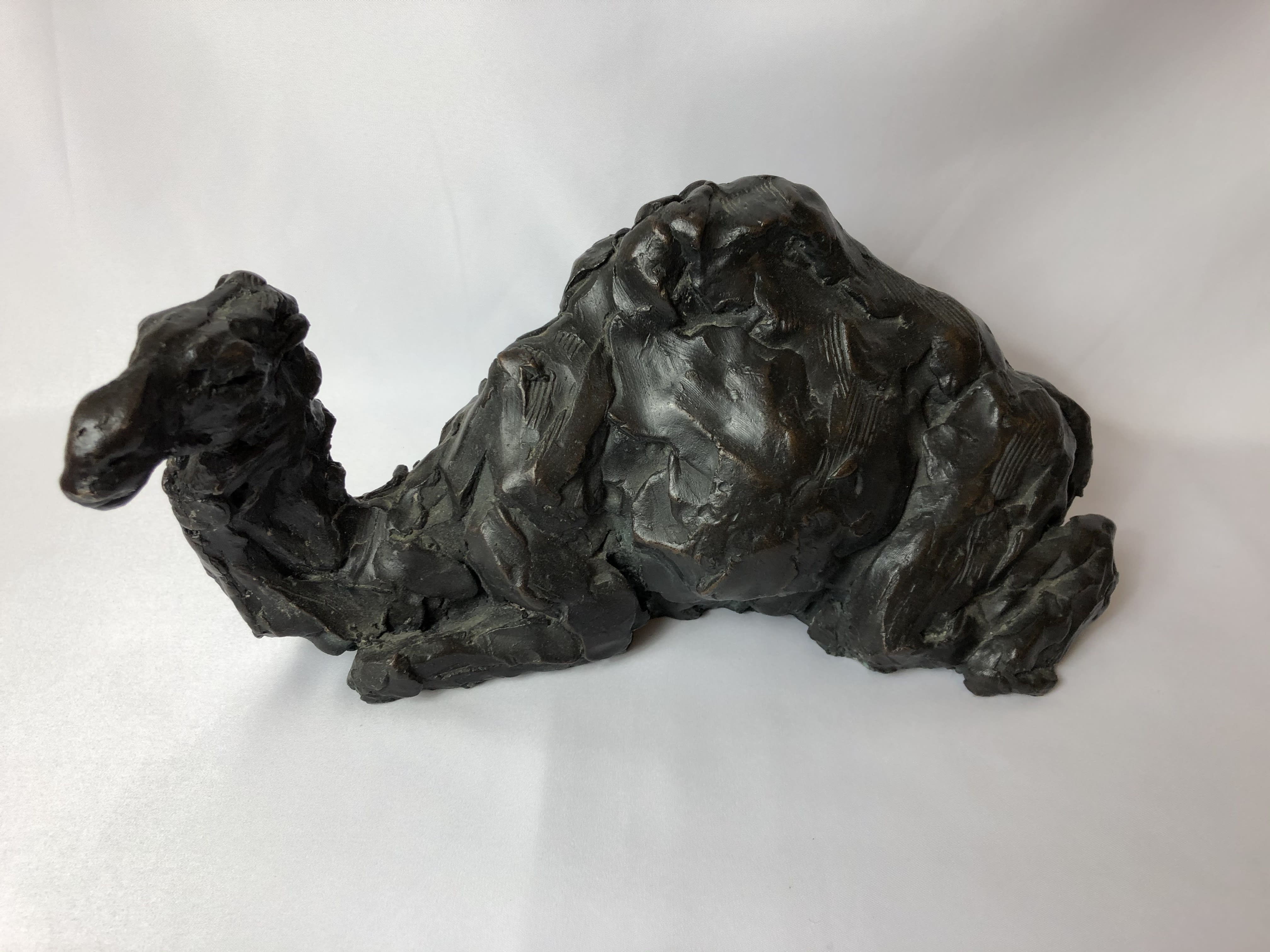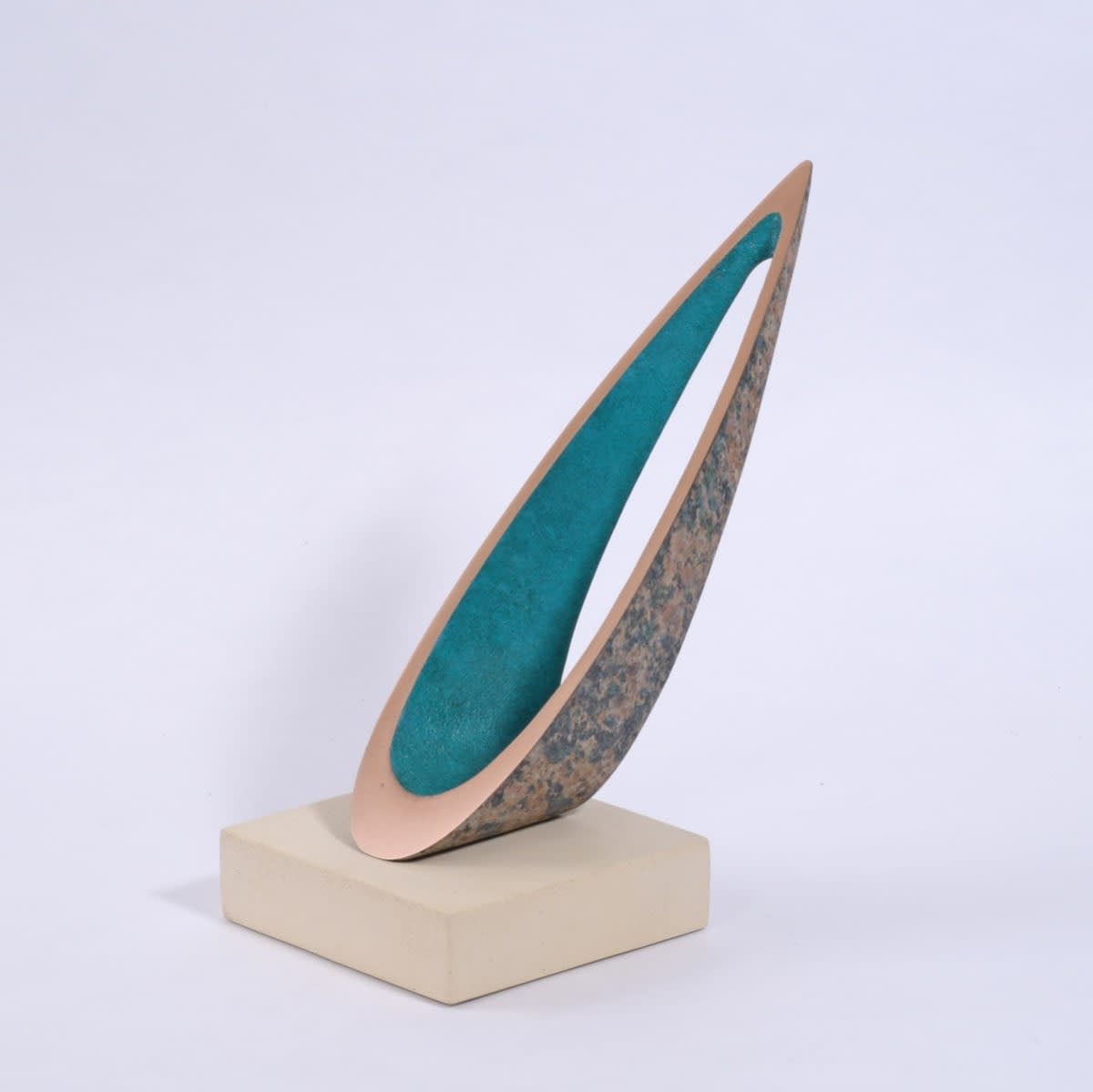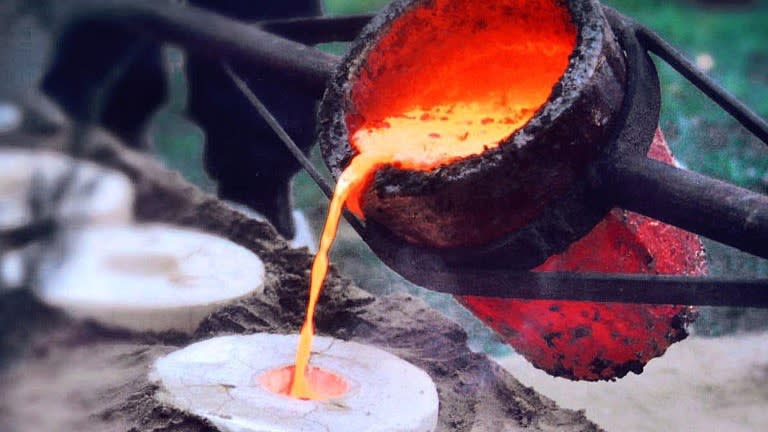 (Image: Liquid bronze at 1200°C is poured into a casting mould. Photo by Takkk via Wikimedia Commons [CC BY-SA 3.0])
(Image: Liquid bronze at 1200°C is poured into a casting mould. Photo by Takkk via Wikimedia Commons [CC BY-SA 3.0])
Bronze is an incredibly versatile medium.
It can be melted and poured, cut, welded, polished, and treated to give a vast array of attractive finishes and patinas. We have a number of brilliant pieces in bronze by Adam Roud, Domenica de Ferranti, and Philip Hearsey in our Winter Exhibition, and they all approach the material differently. If you've considered starting a collection of bronze works, or are simply interested in understanding the techniques these artists use a little better, we've got a straightforward guide to the history of bronze casting and how contemporary sculptors are breathing new life into this timeless process!
classical origins:
a short history of lost wax casting
The ancient "lost wax" casting process has been used for millennia, but it was rediscovered during the Renaissance. Perhaps the most iconic example of this technique, Donatello’s ‘David’ (c. 1440s) is considered the first free-standing bronze statue produced since antiquity.
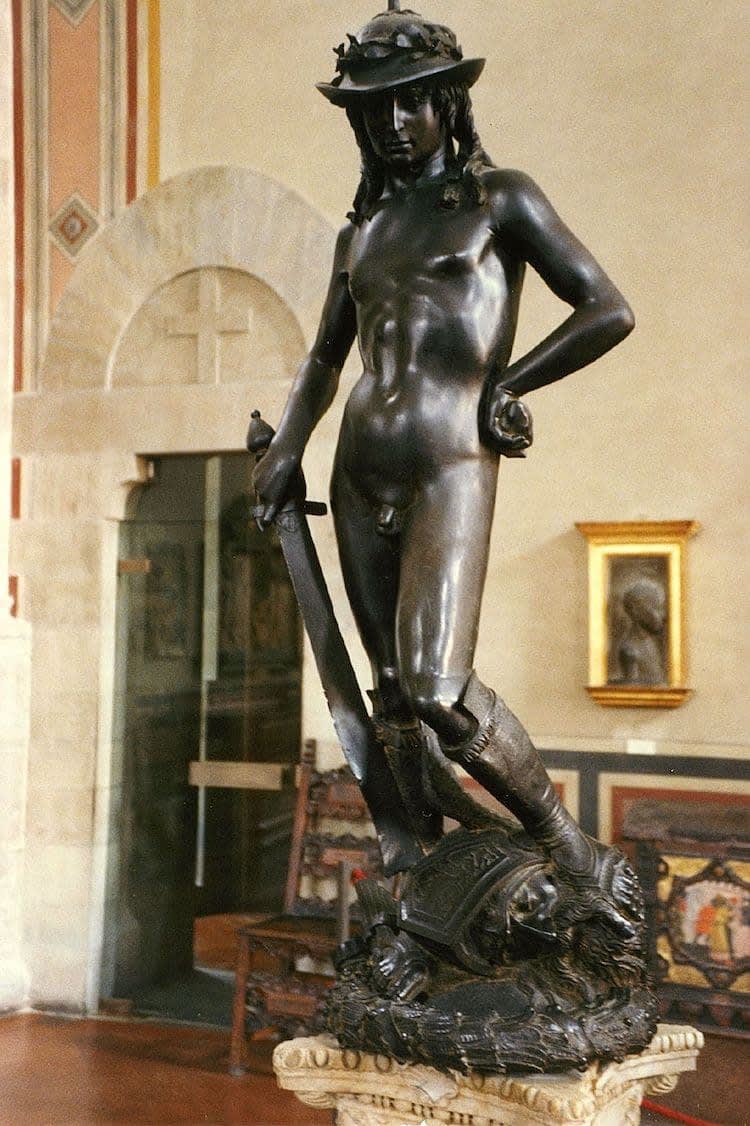
(Image: Donatello, David, c. 1440s, bronze. Museo Nazionale del Bargello, Florence. Photo by Patrick A. Rodgers via Wikimedia Commons [CC BY-SA 2.0])
Even by the 16th Century Donatello was praised for the work's lifelike sense of movement: “…he brought his figures to actual motion, giving them such vivacity and liveliness that they can stand beside the works of to-day, and, as I have said, beside the ancient as well” (Giorgio Vasari, 'Lives of the Artists', c. 1568). These animated qualities were made possible by the lost wax technique’s unique capacity for detail, as well as bronze’s strength – far more durable than marble, casting in the metal allowed for much more bravado when it came to representations of limbs and bodies in movement.
The process:
The techniques used by artists today are remarkably similar to those of the Renaissance masters.
- The sculptor starts by building up a central, usually clay, core to establish the overall shape of the work, sometimes adding finer details which are carried over into the final sculpture.
- The core is coated in a layer of wax. This wax skin can further be carved in detail and manipulated.
- The sculptor attaches a tree-like network of wax sprues to the finished model, before setting the whole thing in plaster or clay; when this mould is fired, the sprues become channels through which the melting wax can pour out - hence the name "lost wax"!
- The melted wax leaves a hollow shell into which molten bronze can be poured, setting around the original clay core. Once cooled, the bronze can finally be chipped free from the mould.
- Any imperfections or signs of the casting process can be “chased” away – removed using an incredibly hot metal tool.
- The sculptor can now choose to treat the surface of the bronze through patination, chemically oxidising the metal to protect and preserve the sculpture as well as alter and enhance its colour.
This involved and step-intensive process allows for highly intricate work and gives a great degree of control to the artist. A thinner layer of wax can preserve the shape and texture of the clay core, while thicker wax coatings can be smoothed, carved in detail, or built up for a more textural finish. Both Adam Roud and Domenica de Ferranti exploit these qualities to create highly expressive contemporary pieces that respond to the inherent properties of clay, wax, and bronze.
adam roud:
the artist's touch
Adam Roud, Hunter, bronze with stone base, 35cm x 30cm x 10cm (base 10cm x 23cm).
Adam Roud's sculptures deliberately retain the textural qualities of his initial clay models. Trained in casting at Hampshire's Morris Singer foundry (where 20th century icons such as Paolozzi, Hepworth, and Moore had many of their works cast), Roud ensures that the tactile process of building up the material is still visible in the finished work.
In 'Hunter', you can see the hand of the artist at work. His layering, squashing, and scraping of the soft clay is laid bare in the final sculpture. The finished piece, however, is anything but soft. Roud's painterly gestures, now preserved in richly patinated bronze, form the tense, muscular body of a poweful horse.
Adam Roud, Pricket, bronze, 48cm high, edition of 12.
A skilled draughtsman, Roud describes many of his sculptures as a "three-dimensional sketchbook". His drawings, as well as his bronzes, play with line and shadow. Particuarly evident in "Pricket", his strong sense for contour along with the coursely worked surface transforms the sculpture, giving it almost the qualitiy of a rough yet confident drawing in heavy pencil or charcoal.
Other monumental bronzes by Roud explore non-representational forms, with clean lines and bold, distinct areas of light and dark. Isolated from the rest of the sculpture, some passages of Pricket almost resemble abstract experiments, with shadows that play over rough exterior and change with the light. The dramaticly positioned hind leg draws the viewer's gaze to the animal's eye, which in striking contrast to the uneven surfaces that surround it, is delicately carved - a level of detail only made possible by the lost wax method.
domenica de ferranti:
interior and exterior rhythms
Trained in classical techniques in a Florentine Atelier, Domenica de Ferranti draws inspiration from her extensive travels. Frequently blurring the line between human and the animal, her works often evoke hybrid forms enraptured in ecstatic movement and dance. Unlike Donatello’s graceful Renaissance contrapposto, movement in de Ferrenti’s sculptures expresses “wildness and natural states of joy or fear” and “those moments our most animal self appears”. Even in more subdued works, such as those in our Winter Exhibition, the evidence that remains of the artist’s own touch invests the work with a living presence, and creates a highly expressive textural quality that suggests the primal energy inherent within every organic subject de Ferranti approaches.
Domenica de Ferranti, Camel, bronze, 33cm x 11cm x 15cm.
Her sculpture 'Camel' shows evidence of the moulding, pinching, and scraping of the original clay and wax model, with light scratches in the surface enough to suggest the animal’s coarse hair. Instead of resting on an elevated plinth or base, the sculpted camel sits directly on a surface, its legs curled beside its stomach. It appears as one sculptural mass, with a sense of weight and solidity, a quality only enhanced by the thick, almost tar-like patina. The work has a stillness to it. However, the almost pulsating surface suggests an energy bubbling just under the surface, as if the creature could get up at any moment. Her subjects carry a powerful potential for movement and action.
“As a sculptor, I aim to create work that is tactile. I am attracted to simple forms but also strive to provoke a deeper understanding of the subject through creating rhythms in the handling of each sculpture”.
Image: Domenica de Ferranti, Hunter, Hadzabe Tribe, bronze, 31cm x 20cm x 25cm, edition of 9.
In 'Hunter, Hadzabe Tribe' de Ferranti further exploits the lost wax technique's capacity for far more elaborate and intricate sculptures – particularly in the delicacy of the sitter’s fingers, the incredibly fine string of the hunter's bow, and the care with which she depicts it curling around the top and bottom of the weapon.
PHILIP HEARSEY:
simplicity in sand
In marked contrast to the other sculptors, Philip Hearsey uses sand casting to produce his abstract bronze sculptures, a process he describes as "worlds away" from the complexities of the lost-wax method. In the Twentieth Century sand casting was widely used for the mass-production of cast metal machinery. Significantly more straightforward than wax casting, it requires a solid pattern (instead of a pliable core) to be packed tightly in a box surrounded by sand. Once the pattern is removed, it leaves an impression into which molten metal is poured.
Philip Hearsey, Stack, 2019, bronze composite, 27cm x 13cm x 26cm.
Because the sand preserves far less detail, the casting procedure demands simplicity of form. Hearsey’s works, however, are far from simple. Emerging organically from his imagination and inspired by “the experience of being in a landscape” his basic patterns, once cast, go through an extensive process of refinement. The metal is polished, patinatted, cut, and washed with colour – working instinctively with the qualities of the medium itself to produce a unique object.
In 'Stack' Hearsey contrasts various levels of finish - from the warm natural colour of the exposed bronze, to the heavily oxidised, rich turquoise of the inner surface, and the dappled patina of the exterior. This luscious verdigris, like rust, often takes years to develop naturally. By using different states of oxisidation in one work, Hearsey invests the piece with a timelessness, blurring the line between organic and inorganic processes.
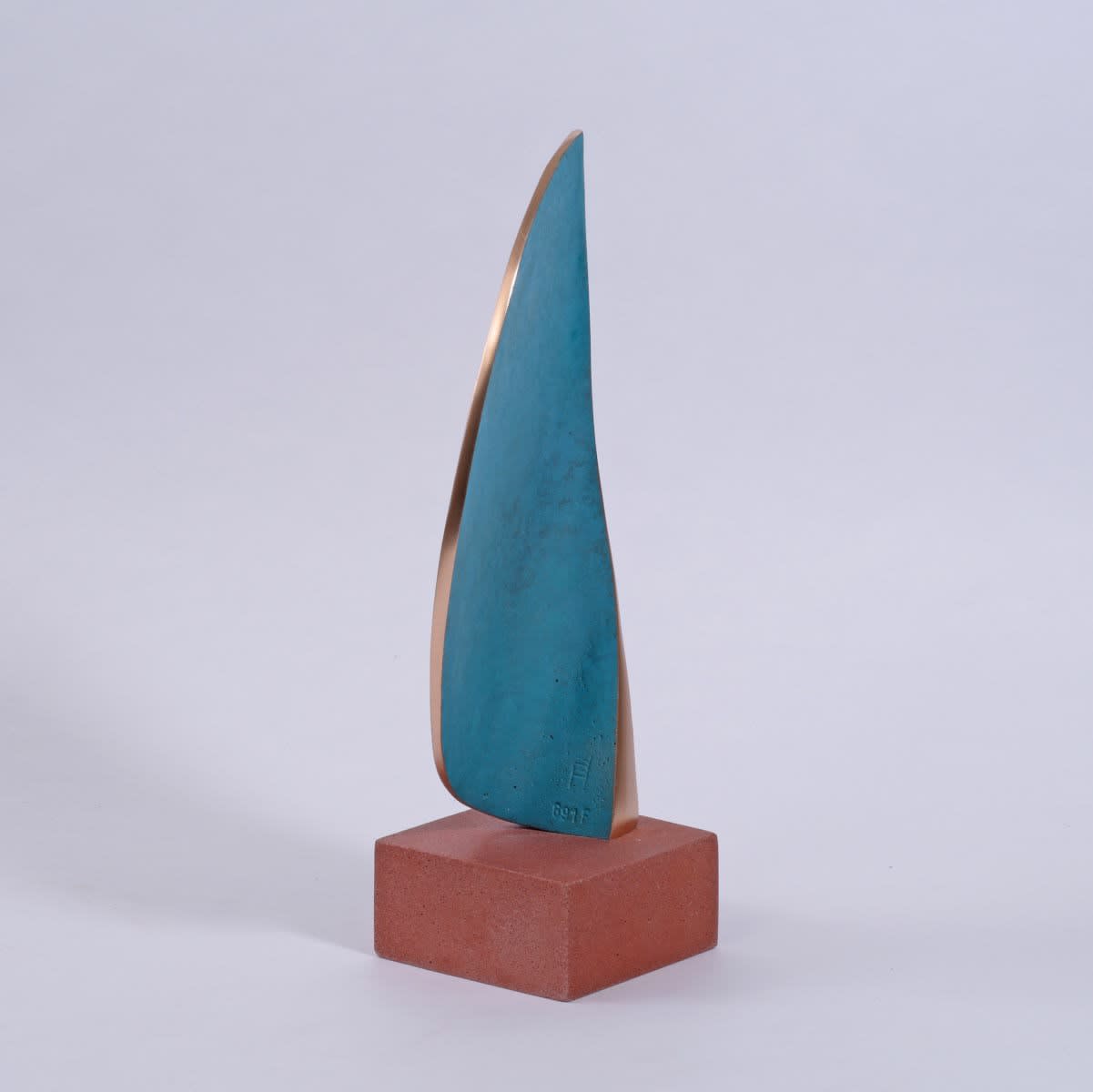 Philip Hearsey, Slipaway, 2019, bronze composite, 36cm x 10cm x 10cm.
Philip Hearsey, Slipaway, 2019, bronze composite, 36cm x 10cm x 10cm.
Trained as an architect, Hearsey's experience designing in wood influences his relationship with metal. Working physically with the constraints and characteristics of a solid material, through touch and exploration, underpins his process. However, he is also open to the unpredictability of the process, embracing the imprecise nature of sand casting. Imperfections, like the potmarcking on 'Slipaway' (2019), become part of the character of his sculptures, which take on a life of their own once they leave his studio and enter a domestic or private setting.


